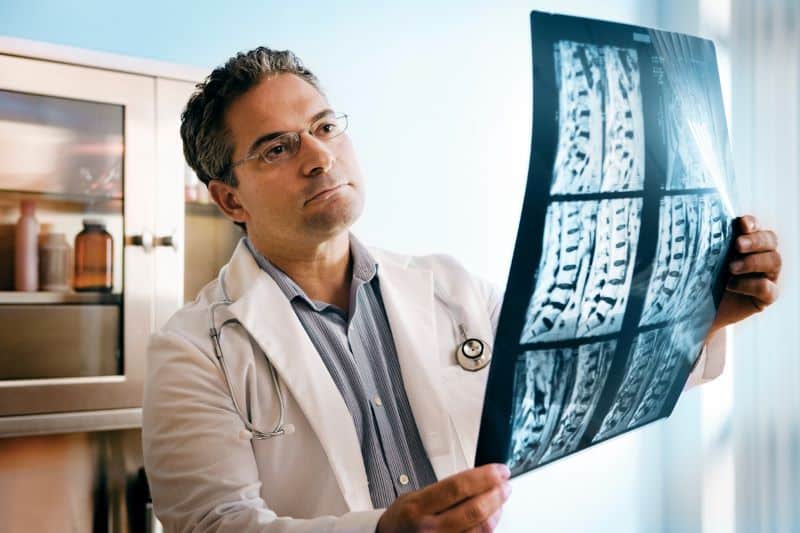Spinal cord injuries are some of the most devastating types of physical injuries. They may result in severe, life-changing physical limitations, including paralysis. After an accident, understanding spinal cord injury causes and symptoms can help victims move forward. Our spinal cord injury attorneys share what you should know.
What Is a Spinal Cord Injury?
The spinal cord is the nerve tissue that runs from the brain down the back. It sends signals between the brain and the body. The spinal cord has protective membranes surrounded by bones called vertebrae. Together with the brain, the spinal cord coordinates feelings, sensations, movements, and functions throughout the body.
A spinal cord injury (SCI)1 is damage to any part of the spinal cord or nerves. It may interfere with movement or functioning in the body, usually below the location of the injury.
You Deserve Justice. Let our catastrophic injury attorneys help you get maximum compensation. Contact us for a FREE consultation.
What Are the Types of Spinal Cord Injuries?
There are two main types of SCI:
- Complete Spinal Cord Injury – Completely prevents motor function below the site of the injury
- Incomplete Spinal Cord Injury – Leaves some sensory function below the injured area
Spinal cord injuries vary significantly in their severity and harm. Paraplegia and tetraplegia may result. In addition, individuals with SCI often suffer premature death2 at higher rates than the general population.
What Are the 6 Common Causes of Spinal Cord Injuries?
Those who suffered a catastrophic injury were often hurt in an accident. The most common causes of spinal cord injuries are:
- Accidents in motor vehicles
- Falls
- Acts of violence
- Sports or recreational activities
- Medical malpractice or surgical causes
- Other various accidents, including defective products
Among the most common types of SCI, car accidents are the leading cause. According to the Shepherd Center3, car accidents account for 38.29% of SCIs. Falls are the second-leading cause, accounting for 31.32% of injuries. Violence accounts for 13.84% of injuries, and sports are 8.46% of all SCIs.
What Are the Common Symptoms of Spinal Cord Injuries?
Recognizing the signs and symptoms of spinal cord injuries is essential for early treatment. Common spinal cord injury symptoms include:
- Being unable to move
- Loss of sensation; not being able to feel touch
- Not being able to feel hot and cold
- Inability to control the bowel or bladder
- Spasms and unusual reflex activity
- Changes in sexual function and fertility
- Stinging or tingling sensations
- Impaired breathing or an inability to cough up from the lungs
- Back pain or a feeling of pressure in the head or neck
- Paralysis, problems walking
Paralysis or numbness isn’t always immediate after the injury. It’s crucial to seek medical attention immediately to prevent additional harm.
When a spinal cord injury occurs, many patients suffer ongoing complications associated with the SCI that can significantly affect their quality of life. These complications may include:
- Bladder and bowel control
- Circulation issues
- Pressure injuries
- Respiratory conditions
- Loss of bone density
- Loss of muscle tone
- Chronic pain
- Depression
How Do You Diagnose a Spinal Cord Injury?
Medical care professionals use a variety of techniques and tests to diagnose SCI4. They may use any of the following:
- Examining sensory function
- Testing the victim’s ability to move
- Learning about how the accident occurred and likely injuries
- X-rays, which may reveal fractures, degenerative problems, and other spinal cord problems
- CT scans, which take cross-sectional images
- MRI, to look at the spinal cord and masses that may be putting pressure on the spinal column
- Muscle strength testing
- Pinprick sensation evaluation
- Sensitivity to touch
- Additional testing once the swelling has improved
- Electromyogram (EMG), to test electrical activity in nerve cells (not common)
Remember that spinal trauma typically coexists with other injuries. Medical care professionals examine all the injuries using a variety of techniques.
Did You Suffer a Spinal Cord Injury? Contact our team today to schedule a FREE case evaluation to see what your claim may be worth.
How Do You Treat a Spinal Cord Injury?
A spinal cord injury is an emergency. Medical care providers must take immediate action and treatment measures and plan for the victim’s long-term care.
Emergency Treatment for SCI
- Immobilization to prevent further injury
- Stabilization
- Ensuring the victim can breathe
- Corticosteroid injection to improve blood flow and reduce inflammation
- Surgical decompression
- Treatment for infection
Long-Term Care for SCI
- Devices and technology to enhance independence
- Assistance to improve the quality of life
- Treating nerve function if injuries are partial
- Addressing complications like loss of control over bodily functions
- Pain management
- Monitoring risk of heart and lung complications
- Prevention of respiratory complications through diet, exercise, flu and pneumonia vaccines, and coughing
A person who suffers a spinal cord injury or other brain injuries needs immediate treatment. Stabilization ensures that the victim’s vital functions are protected, including breathing. In addition, it prevents future harm and reduces swelling. A patient may need sedation to prevent future damage.
Is a Spinal Cord Injury Grounds for Personal Injury Compensation?
If an SCI results from another party’s negligence or more serious conduct, the victim may claim financial compensation. With the leading causes of SCI being car accidents, slip and falls, and intentional injury, most SCI victims qualify for monetary compensation.
Speak to a personal injury lawyer to see if you qualify to file a catastrophic injury case and what it may be worth. SCI often requires long-term care and extensive medical treatment. With a legal claim for compensation, you could recover damages, including:
- Medical bills
- Rehabilitation costs
- Nursing care
- Ongoing medical support
- Lost wages
- Loss of consortium
- Pain and suffering
How Can a Catastrophic Injury Attorney Help Spinal Cord Injury Victims?
An SCI is a significant injury. The victim’s life is likely no longer the same. They may have significant physical limitations and need personal care for the rest of their life. Spinal cord injury case damages should reflect all these losses.
A spinal cord injury lawyer can help victims and their families address long-term care needs in the claim. Even if the victim hasn’t incurred the losses yet, a personal injury claim should include damages that are likely in the future. Pain and suffering damages should be significant, but the victim must effectively articulate the nature and severity of these damages.
Catastrophic injury litigation ensures the victim has the financial compensation they deserve and helps victims and their families with the many tasks necessary to receive support for a severe and life-changing injury to the spinal cord.
If you have suffered a spinal cord injury, contact our attorneys for a FREE consultation. We can help you claim the compensation you deserve.
Sources:
1MedlinePlus.gov. (26 January 2022). Spinal Cord Injuries. Retrieved 22 March 2022.
2Spinal Cord Injury Information Pages. Spinal Cord Injury Facts & Statistics. Retrieved 22 March 2022.
3Shepherd Center. Spinal Rehabilitation Center: Injury and Paralysis Information. Retrieved 22 March 2022.
4Mayo Clinic. (2 October 2021). Spinal cord injury – Diagnosis and treatment. Retrieved 22 March 2022.




